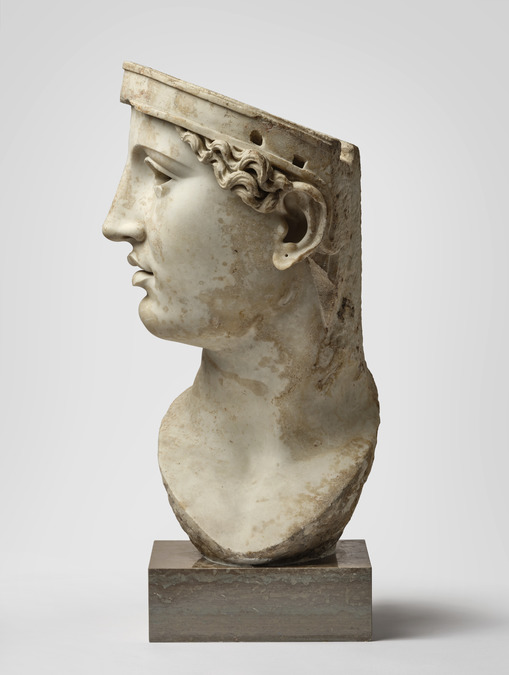Dea Roma
Summary
The statue head here is that of Dea Roma, a iconic personification of the city of Rome. Only the neck, head, and part of the chest remain, including the headband from her Minerva-style helmet and elements of her stylized wavy hair. The head was discovered together with the foot, and due to the size of both it can be concluded that both were once part of a colossal statue of Dea Roma, despite sharing similarities with other deities from the Roman Pantheon.
Description of object
The facial features of the statue are prominent with large eyes, nose, full lips, and a powerful chin. The well-preserved face with its fierce twist of the head to the right must have been even more dynamic when possessed of its inlaid eyes, metal earrings, and the independently crafted helmet. The mouth is open revealing a row of teeth. The neck, which is turned to the right, has a wedge-shaped chest piece coarsely hewn for insertion in a body of another material. The head was discovered together with the foot (IN 569), and because of the colossal size and the piecing technique involved, belonged in all probability to a cult image. The foot shows that the statue was an acrolith with the exposed parts of the body carved in marble, while the helmet, and possibly the costume, were executed in another material. It has also been suggested that the red paint on the face may be evidence of an original gilding, which would support the contention that this was a cult statue. The head and foot were formerly interpreted as a representation of Minerva, the Roman version of Athena, but a far more convincing explanation of the dramatically turned head and the foot with upturned toes is a seated cult statue of Dea Roma.
Dea Roma is most frequently represented seated, with one leg stretched out and the other drawn back so that the toes are turned up as on IN 568. The face is seen in profile, while the torso is frontal, which also explains in the dramatic turn of the head. Dea roma is normally dressed in a sleeveless chiton, which was loosened at one shoulder that exposed the breast, as is the case with the representations of amazons. There is often a cloak over the back and around the abdomen. On her head she wears a helmet like Minerva, with several more attributes also being identified with Minerva’s characteristics.
Dea Roma is a personification of the city of Rome itself. The personified city is a phenomenon with origins in the Hellenistic world, and the cult of dea roma emerged in the eastern mediterranean world in the 2nd century BC as a surrogate for a ruler cult. In Italy, however, Dea Roma appears as far back as the 3rd century BC on republican coinage, though it was not until the reign of Augustus that the cult of Dea Roma reached the city of Rome itself. among the places she appears is on Augustus’ Ara Pacis – the altar of peace – in Rome. The city as a common existence was treated almost like a person; it was a living, breathing entity which needed clothes, food, entertainment and adornment. Like other city goddesses, Roma was personified as a woman, who stood for city and state, and this figure gradually came to be revered as a goddess.. The goddess Roma was promoted by the emperor, who wished to have himself represented as a servant of the city and its population. The image of the goddess Roma possessed considerable power and was often used on coins minted by the emperor in celebration of a victory, or peace and stability.
The iconography associated with Dea Roma can be found elsewhere around Rome. The emperor Hadrian gave the cult of Roma a centre in the city through the construction of a temple, near the Arch of Titus in the Forum Romanum. Another monument featuring Dea Roma is the base of the Column of Antoninus Pius, which was set up in the Field of Mars in Rome.
Choice of methods
Visual examination
- Macroscopic
Technical imaging
- UV
- VIL
- IR
Sampling
- XRF
- FT-IR
- Raman
Bibliography
F. Poulsen, 1951, cat. 101;
P.J. Riis, Acta Arch 45 (1974) 124, 126 (figure 3)
E. Berger, Die Geburt der Athena in Ostgiebel des Parthenon (1974) 21, 80, n.t. 14;
G. Despinis, Akrolitha (Athens, 1975) cat. no. 6. pl. 19-20, re (2nd ed. London, 1974)
M. Moltesen, 1987, 152-153, figure 40;
R. Mellor ‘Dea Roma’, ANRW II 17.2 (1981) 950-1030;
J. Huskinson (ed.) Experiencing Rome (Milton Keynes 2000), passim.
- IN 568
- Statue
- 2nd half of the 2nd century A.D.
- Roman Imperial
- White, fine-grain Italic marble.
- Acquired in 1887 from the art dealer Francesco Martinetti in Rome.
- H: 66 cm,: face, H: 32 cm.




